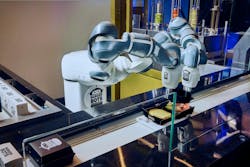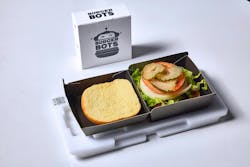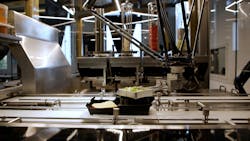BurgerBots serve up fast food at new California restaurant
BurgerBots from ABB Robotics will be serving fast food at a new restaurant concept in Los Gatos, California. Designed to deliver perfectly cooked, made-to-order burgers every time, the automated kitchen uses ABB’s IRB 360 FlexPicker and YuMi collaborative robot to assemble meals with precision and speed. The robots can also monitor stock levels and free staff to focus on customer experience.
“Integrating ABB robots with the BurgerBots restaurant concept demonstrates the incredible potential for automation beyond the factory floor,” says Marc Segura, president of ABB Robotics Division. “The food service industry is dynamic and demanding, and our technology brings industrial-grade consistency, efficiency and reliability to this space. When we asked the hospitality industry, 89% of managers and 73% of workers said they are open to the integration of robotics to automate tasks within their operations. By taking over repetitive and time-consuming tasks, robots allow staff to focus on what matters most – creating memorable dining experiences.”
The compact robotic cell integrates two types of robots with an intelligent inventory monitoring system. As each order is received, a freshly cooked burger patty is placed onto a bun inside a burger box. This box is then positioned on a conveyor shuttle, which is tagged with a QR code (Figure 1). As it moves along the conveyor, the IRB 360 FlexPicker hygienically performs high-speed topping selection, guided by the data stored in the QR code. Next, the YuMi steps in to collaborate on the final assembly of the burger (Figure 2). The entire process takes 27 seconds per burger.
ABB’s robot controller also integrates seamlessly with non-robotic systems, enabling real-time ingredient inventory tracking – onions, tomatoes, lettuce and condiments – ensuring smooth operations and efficient kitchen management (Figure 3).
BurgerBots is the brainchild of entrepreneur Elizabeth Truong, who sees the Los Gatos location as the first step in a broader commercial rollout. “The vision was to bring consistency, transparency and efficiency to food service. For restaurant owners, it means better visibility of food costs, more accurate forecasting and – ultimately – better decision making. In the next five years, I believe that most restaurants will have some form of robotic automation, whether it’s back-of-house preparation, assembly or even front-of-house service. It will become less of a novelty and more of a necessity.”
BurgerBots is the latest in a number of innovations in the food service industry supported by robotic technology. ABB’s collaboration with RoboEatz on ARK – an autonomous robotic kitchen capable of preparing hundreds of meals with minimal human intervention – showcases the potential for high-efficiency, hygienic and customizable food prep. Meanwhile, ABB is powering Makr Shakr’s robotic bartenders, that will soon be expertly mixing drinks in venues around the world. Together, these applications demonstrate how robotics is transforming hospitality with speed and consistency.
The first BurgerBots cell is now open and operating at the chic Breaking Dawn/First Born restaurant in downtown Los Gatos, California. For more information, visit www.burgerbots.com.




